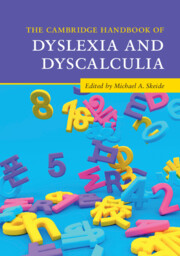Book contents
- The Cambridge Handbook of Dyslexia and Dyscalculia
- The Cambridge Handbook of Dyslexia and Dyscalculia
- Copyright page
- Contents
- Figures and Tables
- Contributors
- Acknowledgements
- General Introduction
- Part I Theoretical Frameworks and Computational Models
- Part II Cognitive Profiles and Behavioural Manifestations
- Part III Genetic and Environmental Influences
- Part IV Neurodevelopmental Foundations
- Part V Gender, Ethnicity, and Socioeconomic Background
- Part VI Cultural Unity and Diversity
- Part VII Early Prediction
- Part VIII Intervention and Compensation
- Part IX Best Practice – Diagnostics and Prevention
- 22 Diagnosis of Dyslexia and Dyscalculia: Challenges and Controversies
- 23 Prevention of Dyslexia and Dyscalculia: Best Practice and Policy in Early Education
- Summary: Best Practice – Diagnostics and Prevention
- Part X Best Practice – Schooling and Educational Policy
- General Summary
- References
- Index
Summary: Best Practice – Diagnostics and Prevention
from Part IX - Best Practice – Diagnostics and Prevention
Published online by Cambridge University Press: 28 July 2022
- The Cambridge Handbook of Dyslexia and Dyscalculia
- The Cambridge Handbook of Dyslexia and Dyscalculia
- Copyright page
- Contents
- Figures and Tables
- Contributors
- Acknowledgements
- General Introduction
- Part I Theoretical Frameworks and Computational Models
- Part II Cognitive Profiles and Behavioural Manifestations
- Part III Genetic and Environmental Influences
- Part IV Neurodevelopmental Foundations
- Part V Gender, Ethnicity, and Socioeconomic Background
- Part VI Cultural Unity and Diversity
- Part VII Early Prediction
- Part VIII Intervention and Compensation
- Part IX Best Practice – Diagnostics and Prevention
- 22 Diagnosis of Dyslexia and Dyscalculia: Challenges and Controversies
- 23 Prevention of Dyslexia and Dyscalculia: Best Practice and Policy in Early Education
- Summary: Best Practice – Diagnostics and Prevention
- Part X Best Practice – Schooling and Educational Policy
- General Summary
- References
- Index
Summary
(1) Diagnostic criteria for specific learning disorders: (a) severity (1.5–2 standard deviations below the average grade-level (not age-level) performance); (b) persistence (a history of difficulties confirmed by repeated assessments and by response to intervention); (c) specificity (typical general cognitive development, but not an IQ discrepancy threshold); (d) unexpectedness (adequate education; sufficient language proficiency; no sensory, neural, or mental disorders; no severe psychosocial adversity); (e) manifestation (confirmed by standardized achievement tests with a high standard of objectivity, reliability, and validity). These criteria need to be tailored to the specific script/number (language) system and cultural educational setting (see Parts VI and X; Chapter 24, Nag 2022) while also taking individual circumstances into account (e.g., motivation, emotions, self-concept, noise, fatigue).
- Type
- Chapter
- Information
- The Cambridge Handbook of Dyslexia and Dyscalculia , pp. 423 - 424Publisher: Cambridge University PressPrint publication year: 2022

